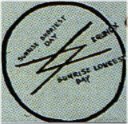| A few preliminary
remarks and imaginations:
My prototype for hura has 4 'balls' in a
crosswise configuration,
and such is also the arrangement of hahe:
 |
 |
|
hahe |
hura |
Maybe the arrangement is meant to depict the 4 cardinal directions.
These do not have to be north, east, south, west, located in the
corners of an imagined square form. The sun does not rise due
north but somewhere in northeast (with the direction changing as the
year advances).
... During his coronation year king
Taufa'ahau
Tupou IV advanced the theory that the Ha'amonga
stones must have served a greater purpose than the more obvious
function as a gateway. This proved the case when closer
investigation revealed a secret mark on the lintel (= threshold)
stone ...

On June 21st 1967 at dawn his majesty was present at
this place and it was a thrilling moment when the sun rose at the
exact point indicated by his interpretation of the lines etched on
the great stone ...
At hahe also the ancient
Mnajdra stone
temple (on Malta) was mentioned. There it was the lines of the
solstices which formed X.
The crosswise configuration is similar between hahe and
hura, but in hahe we can see 'sun-beams' while in
hura
the connecting lines are like tightly drawn strings. I guess these
'strings' indicate 'nighttime', when Sun is 'absent'.
The circular forms (or rather oval - like eggs) are drawn with
simple circumferences, while the crosswise henua signs in hahe presumably allude to the 'enlightened' areas (of 'broad
daylight'). Inside the oval forms we cannot see - what happens inside
eggs is mysterious.
|